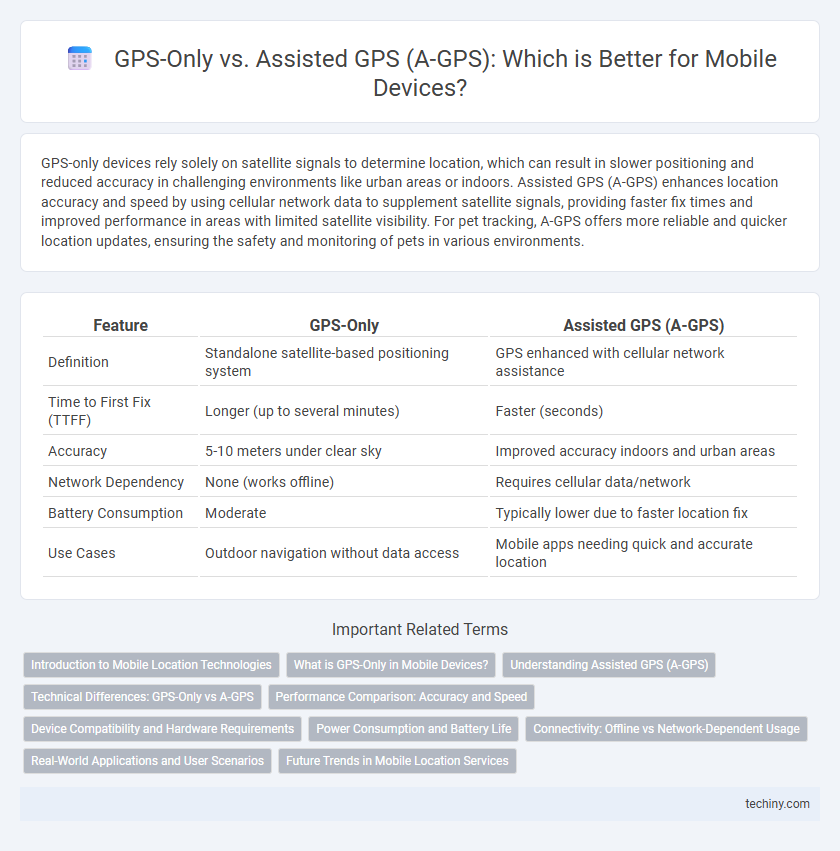GPS-only devices rely solely on satellite signals to determine location, which can result in slower positioning and reduced accuracy in challenging environments like urban areas or indoors. Assisted GPS (A-GPS) enhances location accuracy and speed by using cellular network data to supplement satellite signals, providing faster fix times and improved performance in areas with limited satellite visibility. For pet tracking, A-GPS offers more reliable and quicker location updates, ensuring the safety and monitoring of pets in various environments.
Table of Comparison
| Feature | GPS-Only | Assisted GPS (A-GPS) |
|---|---|---|
| Definition | Standalone satellite-based positioning system | GPS enhanced with cellular network assistance |
| Time to First Fix (TTFF) | Longer (up to several minutes) | Faster (seconds) |
| Accuracy | 5-10 meters under clear sky | Improved accuracy indoors and urban areas |
| Network Dependency | None (works offline) | Requires cellular data/network |
| Battery Consumption | Moderate | Typically lower due to faster location fix |
| Use Cases | Outdoor navigation without data access | Mobile apps needing quick and accurate location |
Introduction to Mobile Location Technologies
GPS-only systems rely solely on satellite signals to determine device location, offering accurate positioning but suffering from slower startup times and reduced performance in urban or indoor environments. Assisted GPS (A-GPS) enhances location accuracy and speed by utilizing cellular network data and Wi-Fi signals to assist in acquiring satellite information quickly. Mobile location technologies increasingly favor A-GPS for real-time navigation and location-based services due to its improved responsiveness and reliability in diverse settings.
What is GPS-Only in Mobile Devices?
GPS-only in mobile devices relies solely on satellite signals to determine location, without using cellular or Wi-Fi networks. This method provides accurate positioning outdoors but can struggle with signal loss or delays indoors and in urban environments. The standalone GPS chip consumes more power and may take longer to acquire a satellite fix compared to Assisted GPS (A-GPS) systems.
Understanding Assisted GPS (A-GPS)
Assisted GPS (A-GPS) enhances traditional GPS by utilizing cellular network data to improve location accuracy and reduce time to first fix, especially in urban or indoor environments where satellite signals are weak. A-GPS leverages assistance servers to provide vital information like satellite ephemeris and timing, enabling faster and more reliable positioning compared to GPS-only systems. This integration significantly optimizes mobile device performance by combining satellite signals with data from cellular towers and Wi-Fi networks for seamless navigation and tracking.
Technical Differences: GPS-Only vs A-GPS
GPS-only devices rely exclusively on satellite signals to determine location, resulting in longer time-to-first-fix (TTFF) and reduced accuracy in obstructed environments. Assisted GPS (A-GPS) enhances positioning performance by leveraging cellular network data, such as nearby cell towers and Wi-Fi signals, to provide faster TTFF and improved location accuracy, especially in urban areas and indoors. A-GPS reduces dependency on satellite visibility by combining satellite and network-assisted data to optimize real-time geolocation on mobile devices.
Performance Comparison: Accuracy and Speed
GPS-only systems provide location accuracy typically within 5 to 10 meters but can experience slower initial fix times, especially in urban or obstructed environments. Assisted GPS (A-GPS) enhances performance by using cellular network data to reduce time-to-first-fix (TTFF) to a few seconds and improve accuracy to within 2 to 5 meters. The integration of satellite signals with network assistance in A-GPS offers superior speed and precision compared to standalone GPS technology.
Device Compatibility and Hardware Requirements
GPS-only devices rely solely on satellite signals for location tracking, requiring a built-in GPS chip and clear line of sight to satellites, which can limit functionality indoors or in dense urban areas. Assisted GPS (A-GPS) enhances location accuracy and speed by using cellular network data, necessitating compatible mobile network hardware and software integration, making it more suitable for smartphones and devices with cellular connectivity. Device compatibility for A-GPS depends on network support and firmware, whereas GPS-only systems function independently but may face slower and less accurate positioning.
Power Consumption and Battery Life
GPS-only systems rely solely on satellite signals for location tracking, resulting in higher power consumption and reduced battery life due to prolonged signal acquisition times. Assisted GPS (A-GPS) enhances performance by utilizing cellular network data to expedite satellite location, significantly decreasing power usage and extending device battery life. Devices employing A-GPS achieve faster location fixes with lower energy demands, optimizing mobile technology efficiency for prolonged usage.
Connectivity: Offline vs Network-Dependent Usage
GPS-only systems operate independently of cellular networks, providing reliable location tracking even in offline or remote environments without network coverage. Assisted GPS (A-GPS) enhances positioning speed and accuracy by utilizing cellular network data, but it requires an active internet connection or cellular signal to function optimally. Consequently, GPS-only is preferred for consistent offline use, while A-GPS excels in network-dependent scenarios offering faster location fixes and improved connectivity.
Real-World Applications and User Scenarios
GPS-only systems rely solely on satellite signals, providing accurate positioning outdoors but struggling in urban canyons or indoor environments. Assisted GPS (A-GPS) enhances location accuracy and reduces time-to-first-fix by using cellular network data, making it ideal for mobile devices in densely populated or signal-obstructed areas. Real-world applications such as navigation apps, ride-sharing services, and emergency response benefit from A-GPS's improved speed and reliability in diverse user scenarios.
Future Trends in Mobile Location Services
Future trends in mobile location services emphasize the integration of GPS-only and Assisted GPS (A-GPS) technologies to enhance accuracy, especially in urban and indoor environments. Advances in A-GPS leverage real-time data from cellular towers and Wi-Fi networks, reducing time-to-first-fix and improving location precision in complex settings. Emerging innovations in satellite constellations and machine learning algorithms will further refine positioning capabilities, enabling more reliable and energy-efficient mobile navigation systems.
GPS-only vs Assisted GPS (A-GPS) Infographic

 techiny.com
techiny.com